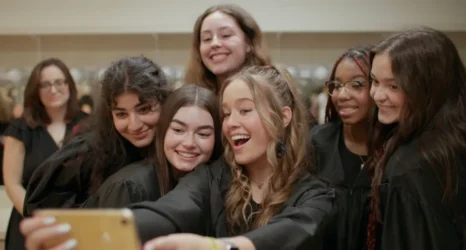SPOILER ALERT: This post contains major spoilers. Also, TRIGGER WARNING: RAPE.
I am not really into gore for gore’s sake: When I go to horror movies, I want to be held in suspense and suddenly surprised, not just grossed out. Luckily for Sam Raimi fans, the new version of the 1981 cult classic The Evil Dead manages to combine both surprise and gore. Using Raimi’s signature vertigo-inducing camera work and long, taut pauses, the new movie keeps you on the edge of your seat—until the tension is broken by something terrifying and you practically jump out of it. It’s also got blood. Lots and lots and lots of blood.
The first Evil Dead was a low-budget film that used such old-fashioned techniques as stop-motion to make bodies appear to melt. Though next-gen director Fede Alvarez also used mostly trick props, body modifications and makeup with very few digital effects, the gore in this film is decidedly more realistic than in the original. Likewise, the new film takes itself and the horror genre far more seriously than its melodramatic inspiration.
Though in a clear homage to Evil Dead II (the 1987 sequel), not just one but two people have to sever their own limbs, 2013’s Evil Dead is not torture porn. Despite its realism, the new movie is still about demons possessing people and doing horrible things to the bodies they are in as well as to the bodies around them. This film is about supernatural evil, not human evil, and the basic human fears it draws on are as much spiritual and psychological as physical. This violence exists not for its own sake, but to teach the characters a lesson, and this time around the lesson is different.
In fact the film is not strictly a remake but rather a “what if five kids showed up at the same cabin from the first Evil Dead and had roughly the same things happen to them that happened to the five kids who stayed there 32 years ago?” Alvarez and Raimi have said they hope to make another Evil Dead II as well, then bring the two story lines together in an Army of Darkness II, implying that the protagonist from this film might meet up with a grown-up Ash (Bruce Campbell) from the first. I hope it happens, because the updates this film makes to the original makes the new movie more feminist.
In the first movie, Ash is clearly at a disadvantage due to his sentimental connection to his girlfriend and his sister. In the Evil Dead world, once a demon possesses a body the only way to get rid of the demon is to dismember the body, burn it or bury it alive. Ash, signified as a girly man by his name—which is really Ashley—cannot accept that the bodies that used to be his loved ones are demons, hesitates to destroy them and suffers as a result. Though at the end Ash is saved by a symbol of his love for his girlfriend, there is no doubt that the lesson he has learned from his bout with evil is that he has to be ruthless.
In the new movie, David (Shiloh Fernandez) has come back to the cabin, which his family now owns, for the first time in years. He brings his girlfriend and meets two childhood friends there to help his sister detox. But David is disadvantaged not by his sentimental connections to the women in his life, but rather by the fact that he has failed to stay close enough to his family. Named like a king, the manly-man David missed his mother’s prolonged illness and death and hasn’t seen his sister in so long he can’t really say he knows her very well. His fight with evil teaches him a very different lesson than the one Ash needed to learn: It teaches him to trust his sister and to be willing to sacrifice himself for his family.
Much to the chagrin of feminists, the new movie does include a version of the infamous tree rape scene in the original, but the changes to it are telling. Whereas in the original, Ash’s sister Cheryl (Ellen Sandweiss) is held down to the ground by the branches of possessed trees, in the new movie, David’s sister Mia (Jane Levy) is held suspended in the air. And whereas in the original the trees are humanized in the ways they hold Cheryl down, the trees in the new film are distinctly trees. The resulting image is more like that of Christ or the figure at the center of da Vinci’s Vitruvian Man than that of a woman being held down by a rapist.
The actor’s response to the rape is also different. Whereas in the original, when penetrated the woman on the ground began to make sexual sounds and to breathe as if having sex, in the new movie the actor is clearly in terror the entire time. This is violence, not sex. Most importantly, though neither Cheryl nor Mia’s friends believe her when she says she was raped, Cheryl never gets any justice, and her brother Ash escapes alive despite his doubts. Mia’s friends, on the other hand, all die, even her brother David, who finally learns that protecting the women in his life is more important than protecting himself.
Bruce Campbell said on Twitter that “Evil Dead is omni-gender in its violence,” but that’s not entirely true. The only sexual assault committed is against a woman, and the only characters who cut themselves are women. But the point of feminism in film is not to avoid representing the horrible things that happen to women; it is to show that women survive despite them.
In the new Evil Dead, Mia is the only one left standing at the end. She slaughters the main demon in an act of physical strength (aided by a chainsaw, natch) that Cheryl could never have accomplished. If only Mia’s friends had believed her instead of dismissing her as hysterical and judging her by her past, they, too, might have lived. But neither what the trees did to her nor the losses she has suffered will hold Mia back. This protagonist will not be a victim again.
At least not until the next Evil Dead II.





